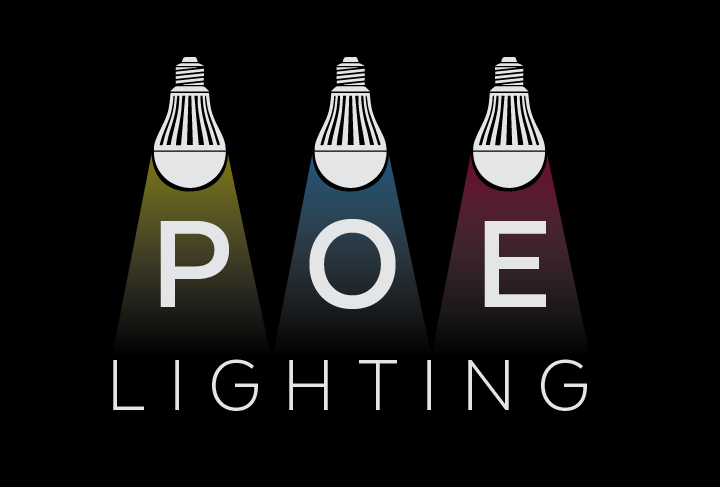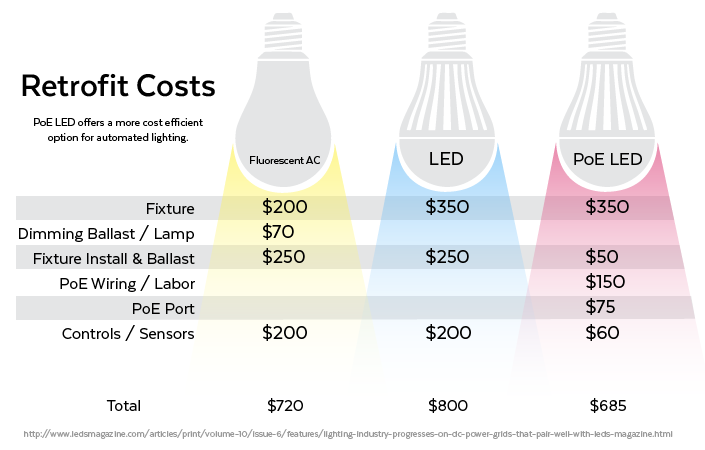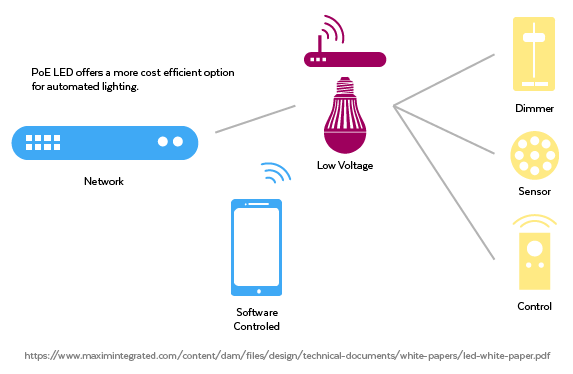Energy-efficiency has driven the evolution of the light bulb, but the next iteration of the light bulb will launch it into the Era of the Internet of Things (IoT). As LED lights slowly replace compact fluorescent lights (CFL’s) due to greater energy-efficiency, businesses have been exploring the profitability of replacing LED lights’ electrical power source with an alternate but common power source found in the networking world — Power over Ethernet (PoE).
PoE delivers power and data via a cat5 or cat6 cable from a power sourcing equipment (PSE) such as a switch directly to the network port of a connected powered device (PD). This enables network administrators to deploy networking devices such as IP Surveillance cameras for example, in locations that do not have access to a nearby power outlet. PoE not only simplifies deployment, but also eliminates the need for hiring a professional electrician to install additional electrical circuitry in an office.
But power sourcing equipment can also provide power to LED lights via a standard networking cable. The ultra-low wattage requirement of LED lights makes it possible for PoE to power these light sources. LED lights boast an average life span of about 50,000 hours and only utilize 6-8 watts of power (in comparison to compact fluorescent lights (CFLs) that have an average life-span of 8,000 hours and consume 13-15 watts of power). The 802.3af PoE standard, the standard with the lowest power output, yields up to 15.4 watts of power and can easily support standard LED lighting power requirements. In the highly unlikely case that PoE LED lighting systems will demand more power, 802.3at can easily provide more power yielding up to 25.4 watts of power.
IT Personnel—The New Electricians?
PoE enables IT personnel and even end-users to install additional LED light sources at nearly any location. With traditional light sources that rely on the power grid of a building, users need to contract a professional electrician and follow extensive conduit rules and regulations. PoE lighting eliminates the need for a costly electrical contractor.
Smart Lighting
But PoE accomplishes more than simplifying deployment. PoE connects LED light sources to the internet and gives users access to “Smart Lighting”. Smart Lighting enables users to remotely control their lighting systems via a mobile client device using the internet.
And unlike regular IoT devices that operate with the Z-Wave and Zigbee home automation standard, PoE LED lighting does not require a home gateway to operate. PoE LED lights receive their own IP address once connected to a LAN network via an Ethernet cable. This makes PoE LED lights ideal for home automation and enterprise usage.
Smart Home Accessorizing
PoE LED lights can also be paired with other smart home accessories. Maxim Integrated asserts that “LEDs can be readily paired with sensors, wireless communication modules, and embedded processors…The collected information could include ambient lighting, temperature, humidity, and anonymous room-occupancy data.” PoE-powered LED lighting networks truly give users the ability to “dynamically monitor and control” their LED lighting system.
Co-Working Spaces
Because PoE gives users a “mobile power source”, office workers can freely modify the lighting of their office spaces. This feature is especially convenient in co-working spaces that are popular in the startup scene where office users may need temporary and custom lighting arrangements. PoE LED lighting allows offices to offer flexible and almost modular-like lighting.
Ambiance
In addition, RGB LED lights allow users to easily choose the color of their lighting.
No Interference
Because PoE LED lights are directly connected to the internet via a network cable, users can expect consistent reliable performance without Wi-Fi interference.
The Future of PoE Lighting
There are several advantages to PoE lighting, including automation, remote control, and the cost-efficiency of Cat5 Cable. InnovativeLighting notes that “Ethernet cables cost very little compared to heavy duty copper wire and conduit used for traditional lighting.” Cost, mobility, and ease of installation are some of the factors that will attract users to invest in these next generation lighting options.
As electronic devices get more energy-efficient, do you see foresee an Ethernet cable charging your cell phone in the future?
Leave us a comment below!
If you’re already adopting this technology, remember to ensure that the appropriate voltage will be delivered to your lighting source. Visit this page to use our PoE calculator.




Join the Discussion 3 Comment